 |
Travels in India and Pakistan
part 1 - Mumbai and Gujerat: Ahmedabad, Palitana, Diu, Somnath, Junagadh, Jamnagar
January 2009
|
Our route from Mumbai through Gujerat, Rajasthan and Punjab to Islamabad in Pakistan.
(the link to part 2, Rajasthan and Punjab, is at the bottom of this page.) |
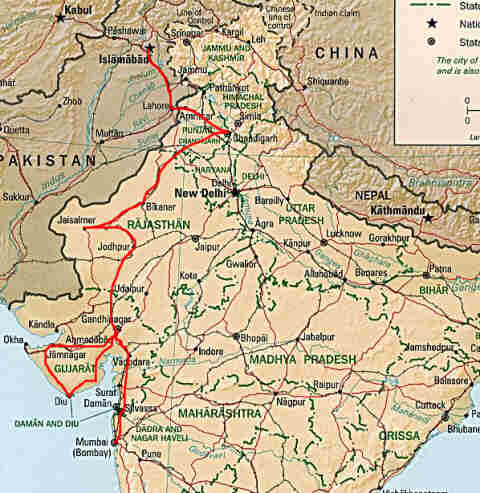
|
Mumbai (Bombay)
|
Sun 11th Jan. We flew on Air India to Mumbai. We went to Bentley's hotel, a recommended option, but it was full so we stayed at the Hotel Antique, where we stayed the last two times we came to Mumbai - in a good location but not a great hotel, but there again we do not spend much time in it.
Mon 12th. After breakfast at Café Mondegar (spicy baked beans with coriander and chopped onion) we walked all the way down Colaba Causeway, trying to reach the point where the causeway ends at the sea, but it is all a military area and there is not much to see, so disappointed, we got a number 103 bus back to the hotel. Overcome by the heat (it was below freezing when we left home) Sheila retired for a nap while I watched the world go by from a window seat in Café Paris, and then Café Day just down the road. About 5pm we decided to go sightseeing, so we got on a random bus on the main road and for the equivalent of 5 pence it took us through the Fort area of Mumbai to Churchgate station. Churchgate was teeming with commuters on their way home so we made a few enquiries for tomorrow and got another bus which took us through the financial district and to the Gateway of India, where we promenaded with the crowds for a while until it got dark, then we walked up the road to Café Mondegar for a couple of refreshing beers and delicious masala peanuts. Kingfisher seems to be the beer of choice in this part of India, we had difficulty finding Cobra anywhere this trip. Back at Café Paris (not quite like the name suggests), almost opposite our hotel, we had an excellent dinner of tandoori chicken, chicken dopiaza and a dhal, before collapsing into bed.
Tues 13th. We set off on the walking tour of Mumbai. We walked up Colaba Causeway to the Regal Circle and continued up MG Road, surrounded by imposing colonial and Art Deco architecture. We went round the Oval Maidan, a grassy area with cricket games and exercise classes going on in the middle and more imposing buildings all around, to end at Churchgate railway station.
|
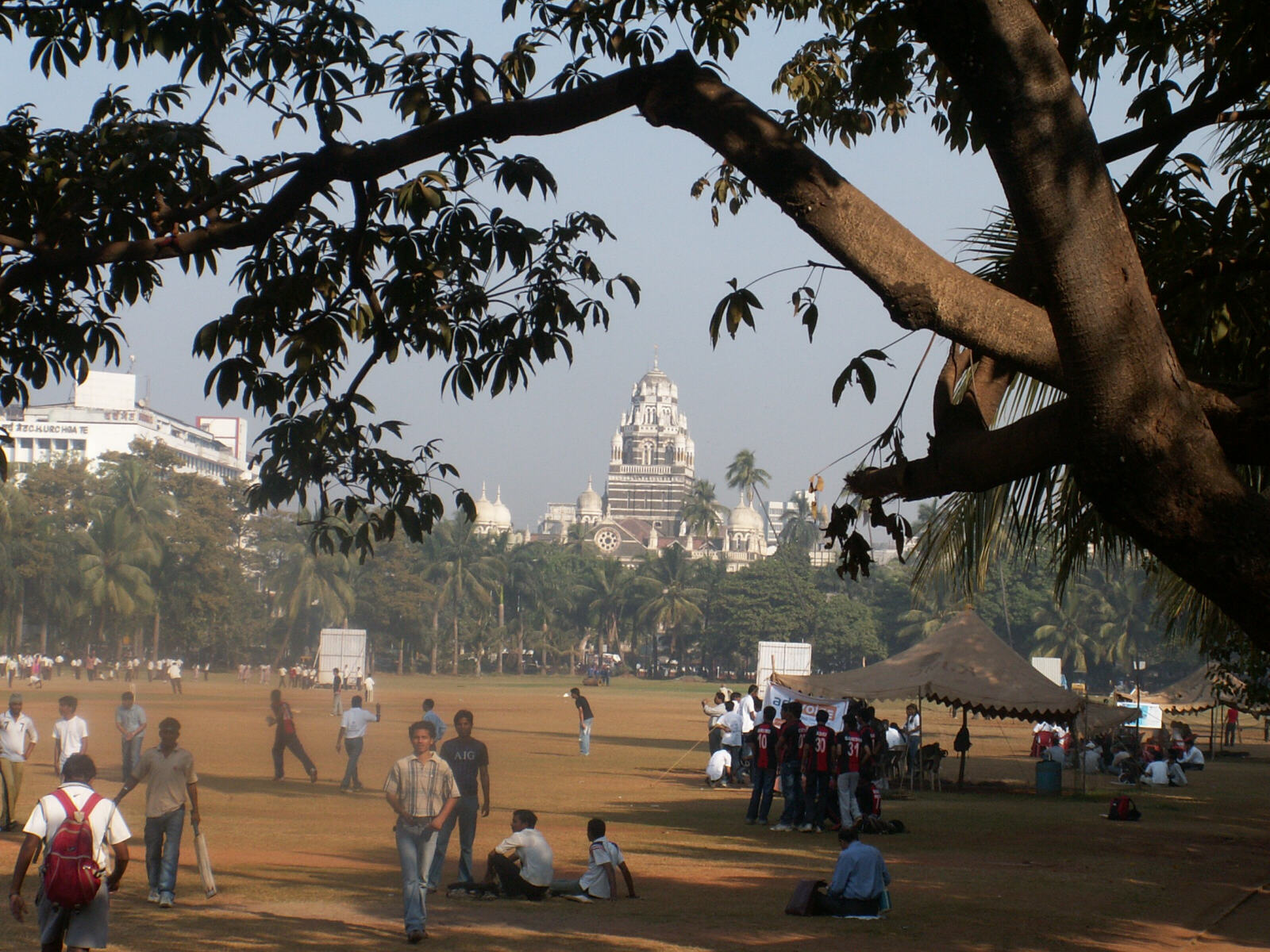
|
We got a train five stops up the line to Mahalaxmi station, where from the bridge just outside we had a panoramic view of the washing ghats, Bombay's 'washing machine' where clothes from most of the laundries in the city are beaten mercilessly against concrete blocks by men standing knee-deep in murky water. |
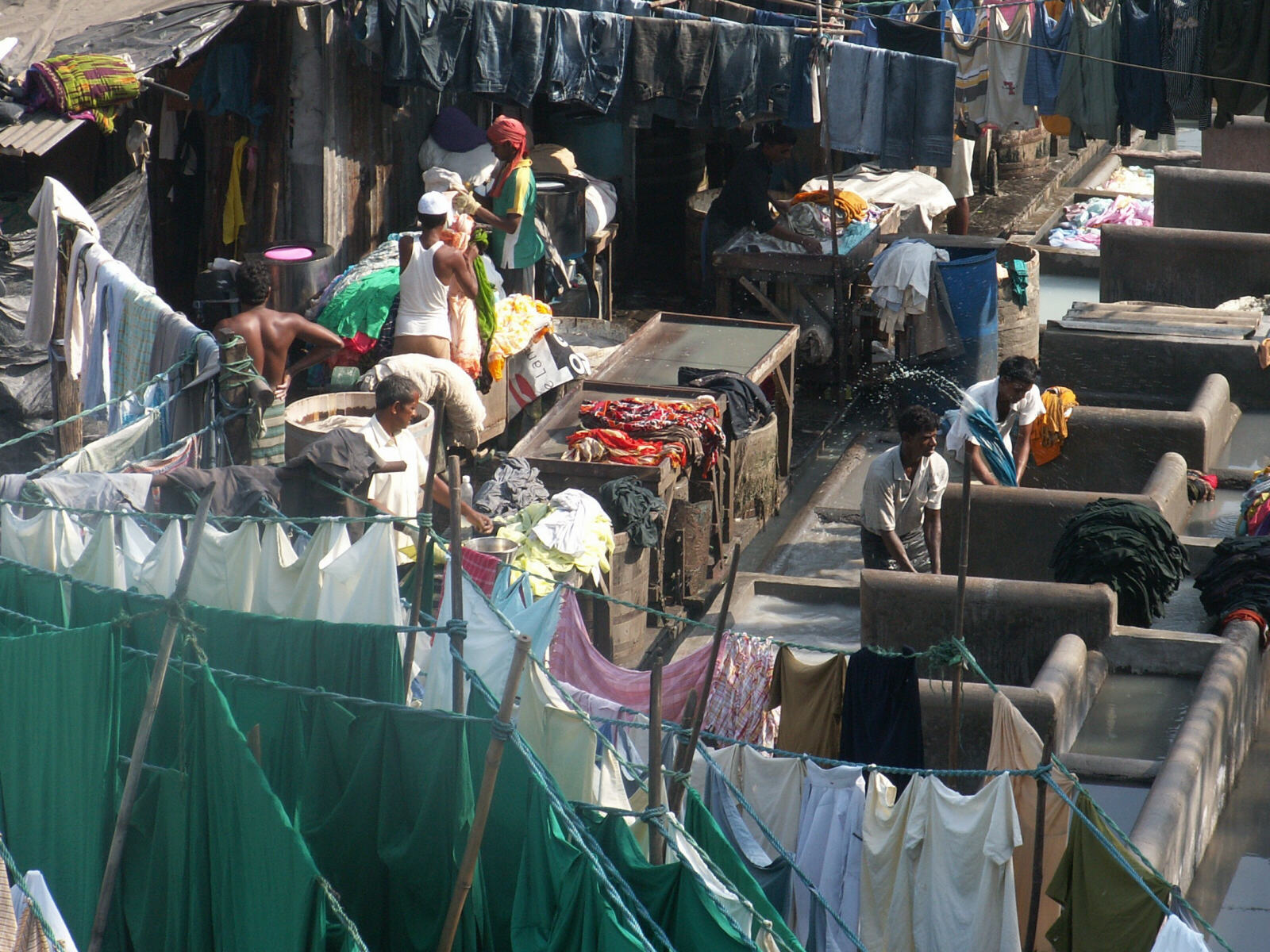
|
All around, football-field sized areas of washing lines are filled with every variety of clothing drying in the sun. |
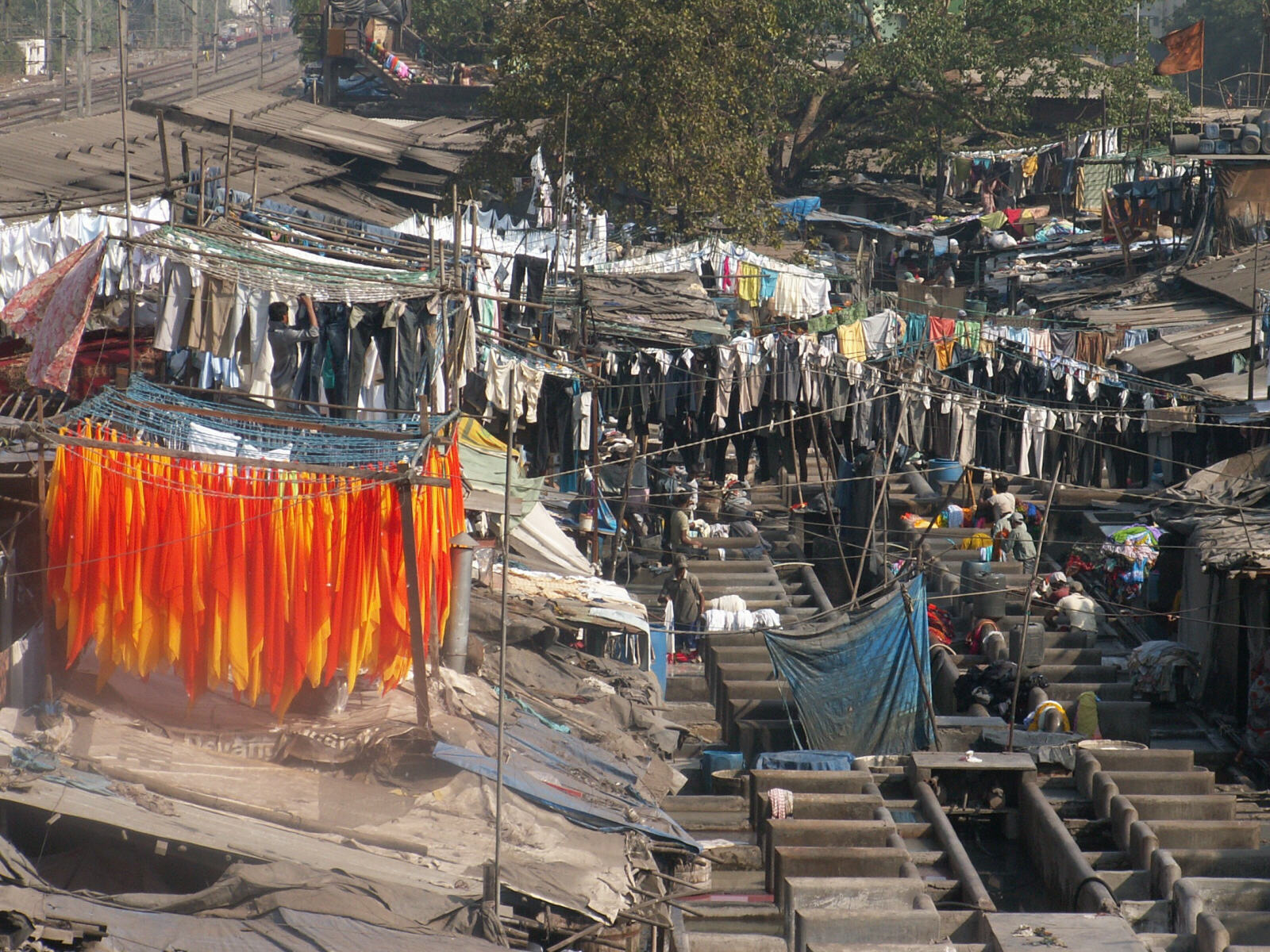
|
We got the train back to Churchgate and went looking for the Metro shopping centre, where our favourite ice cream shop was supposed to be. Last year there was a branch of 'Amore' Italian ice cream parlour near our hotel in Colaba but now it is closed, and we were told this is the next-nearest one. We eventually found it inside the Metro Cinema, where they were very reluctant to let us in because we didn't have a ticket to see a film! Eventually they relented after taking our cameras into safe keeping (presumably to prevent us from making pirate copies of whichever films were showing) and we found the ice cream and sat in the cinema lobby enjoying it. We strolled back looking at the shops, then Sheila stopped at a beauty parlour so I went to the nearby Delhi Darbar restaurant and had lunch of spicy kebabs. At one point we saw a bus go past with this advertisement for an energy drink. We saw a similar one for the same product - "Drink one can of Cloud 9 and drive nonstop for 9 hours". If there was an advertising standards agency, I wonder what they would think of that! |
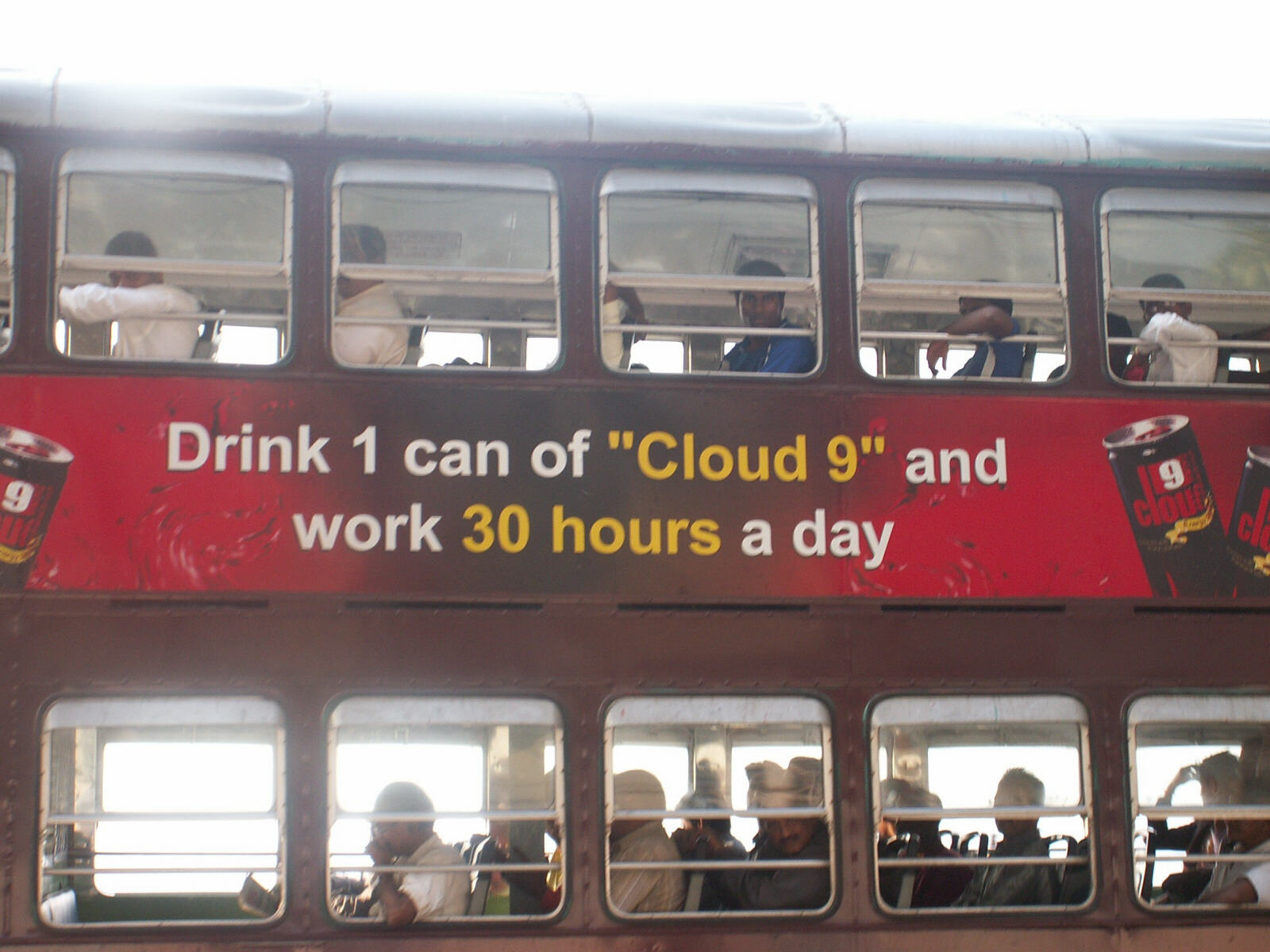
|
Afterwards we jumped on a random bus which took us to the business district where we walked past the office workers having lunch at the row of street stalls, down to the sea which at this point we could only look at through railings across some rather grubby rocks. We got a taxi back to the hotel, washed off some of the city dust, then got a taxi out to Chowpatty Beach in the evening. Chowpatty is where everyone comes out to promenade, fly kites and ride on the little fairground. We also walked inland to the Kotachi Wadi, an oasis of little winding lanes and wooden two-storey houses out of earshot of the roar of Mumbai's traffic. |
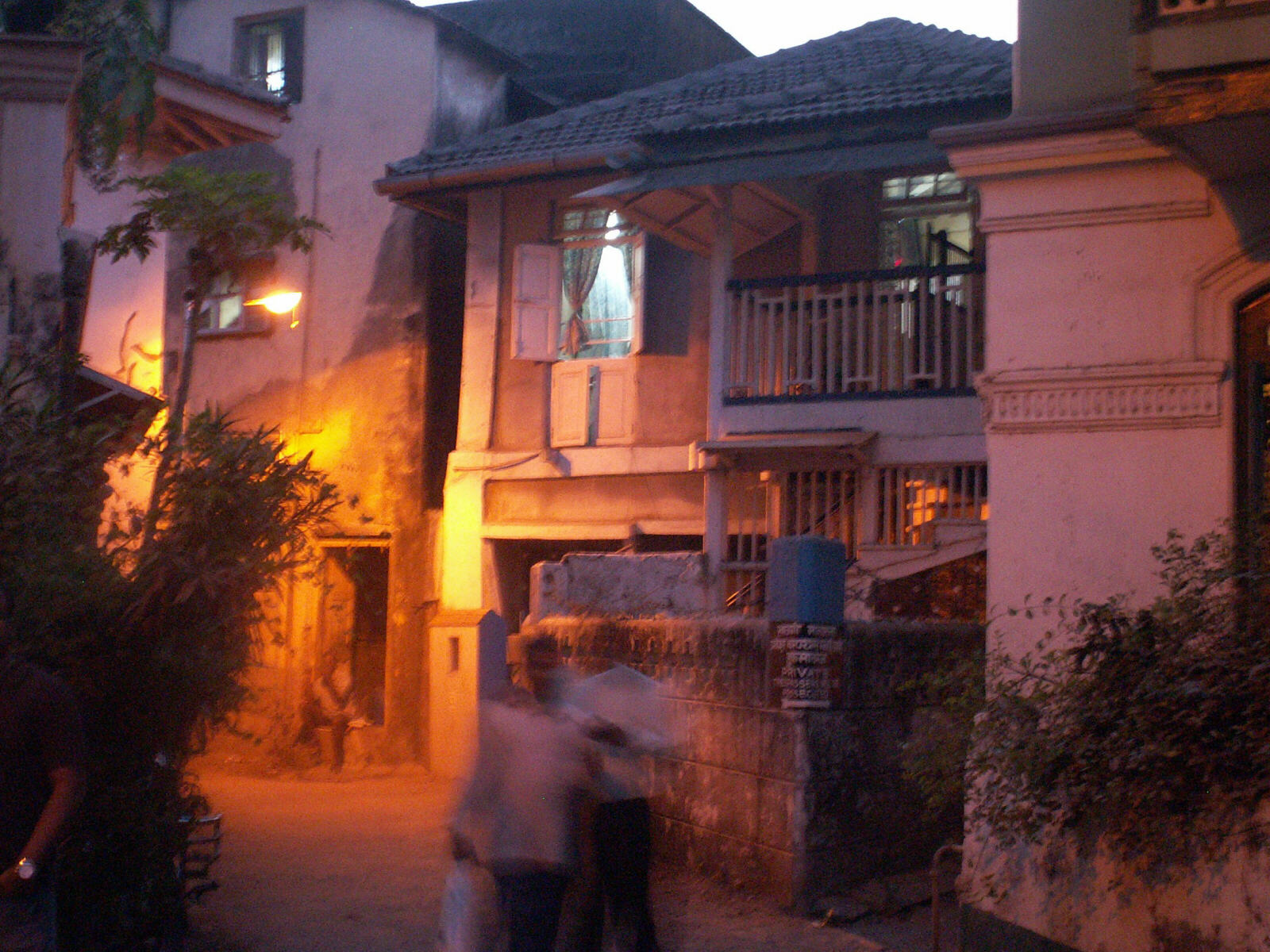
|
Rather than have a snack at the stalls on Chowpatty Beach which were disappointing, we went to the other extreme and had lobster thermidor in the restaurant at the Taj Hotel. It was good to see that much of the Taj was open as normal, although the old building is still being renovated after the attacks last November. We also went there because it was a lobster bisque that started Sheila's tummy troubles last year so she wanted a lobster with happy memories. This one was fine!
Weds 14th. We strolled down to Sassoon dock to see the fish market, although by the time we got there all the fish had been unloaded from the boats and most of the activity was families of women and children sitting round huge piles of prawns, shelling them. Near the dock was the 'fish division' of a bakery, hard to imagine what they were selling! |
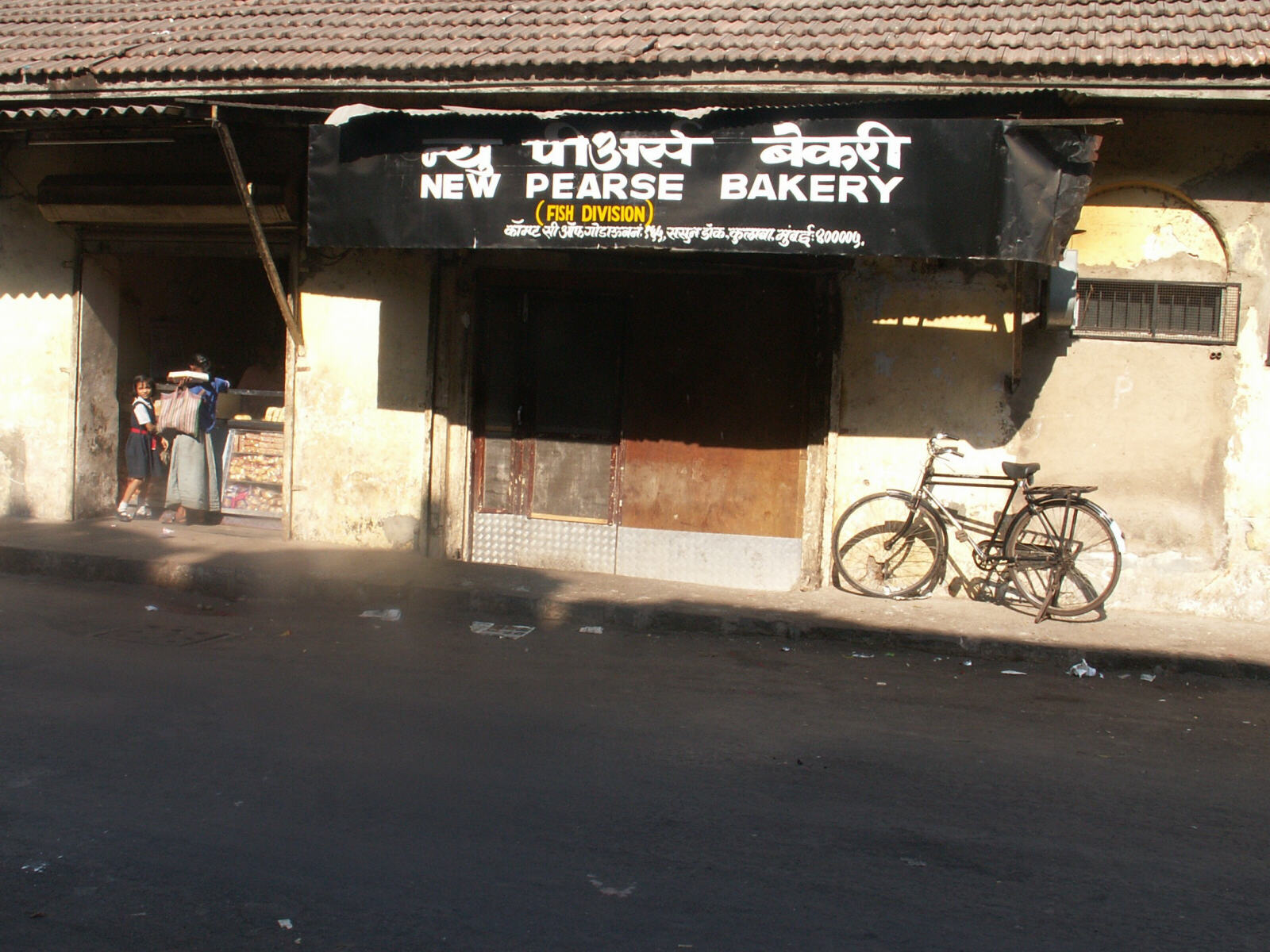
|
We had breakfast at Mondegar's and spent the day wandering around Mumbai, from the street stalls in Colaba to the lobby of the Oberoi, where we sat in luxury for a while to cool off. We walked a little way along Marine Drive by the sea and turned off to look at the highly-recommended Gaylord restaurant, but we were too early and it was not open. Back in Colaba we went to the Indigo Delicatessen for tea and a lemon tart, then after a bit more walking round we had a nice curry and tandoori chicken at the local Delhi Darbar restaurant. Later we caught the 21:30 Gujerat Mail overnight sleeper train to Ahmedabad, where I had to restrain Sheila from smothering a snoring man with a pillow! |
Gujerat state
- Palitana
|
Note, for comparing prices, one pound = about 70 Rupees, one euro = about 64 Rupees.
Thurs 15th. The train arrived at Ahmedabad about 6am and we started trying to find buses to Palitana, at first without success. An auto-rickshaw driver took us to his bus man but he said the bus was full (or we could go by car, but it was a fixed 2500 rupees and he wouldn't negotiate) so we went to the public bus station where there seemed to be a public bus going our way in an hour or so's time, but a tout came over and said he had a 'luxury' private bus which would be much better. In fact it was, with comfortable reclining seats and allocated seat numbers, so for 300 Rs we went the three-hour journey as far as Bhavnagar, then we had to get off and go and wait by a fruit stall at the side of the road for the local bus to Palitana. There was no actual bus stop and we wondered if we were stuck in the middle of nowhere when a rickety old metal-seat bus came along, so we piled on, bought four seats for 50 Rs (two for the suitcases) and were quite comfortable for the hour's ride to Palitana. When we arrived at the bus station we had some difficulty negotiating with an auto-rickshaw driver who wanted a high price to take us to the Hotel Sumeru, but eventually we heaved our suitcases onto the auto-rickshaw, set off, drove round the first corner and there was the hotel - that's the penalty for arriving somewhere without a map.
Hotel Sumeru has a 'dilapidated charm' with wide corridors, big rooms and friendly staff. We had a drink in the restaurant and set out to see the main attraction - the Shatrunjaya Temples spread over a hilltop about a mile from town. The only way to get to the Shatrunjaya temples is up 3,200 steps spread over 2˝ km, and it's hard work when you are as unfit as we are. It is humbling to be sitting panting in the shade as an elderly pilgrim lady goes past and tells you she's been up to the temples 55 times, and her mission is to do it 99 times in her life. You can be carried up in a seat on poles by two porters, but we were determined to do it ourselves - the porters saw that we were struggling and followed us for the first 1000 steps, then gave up! |
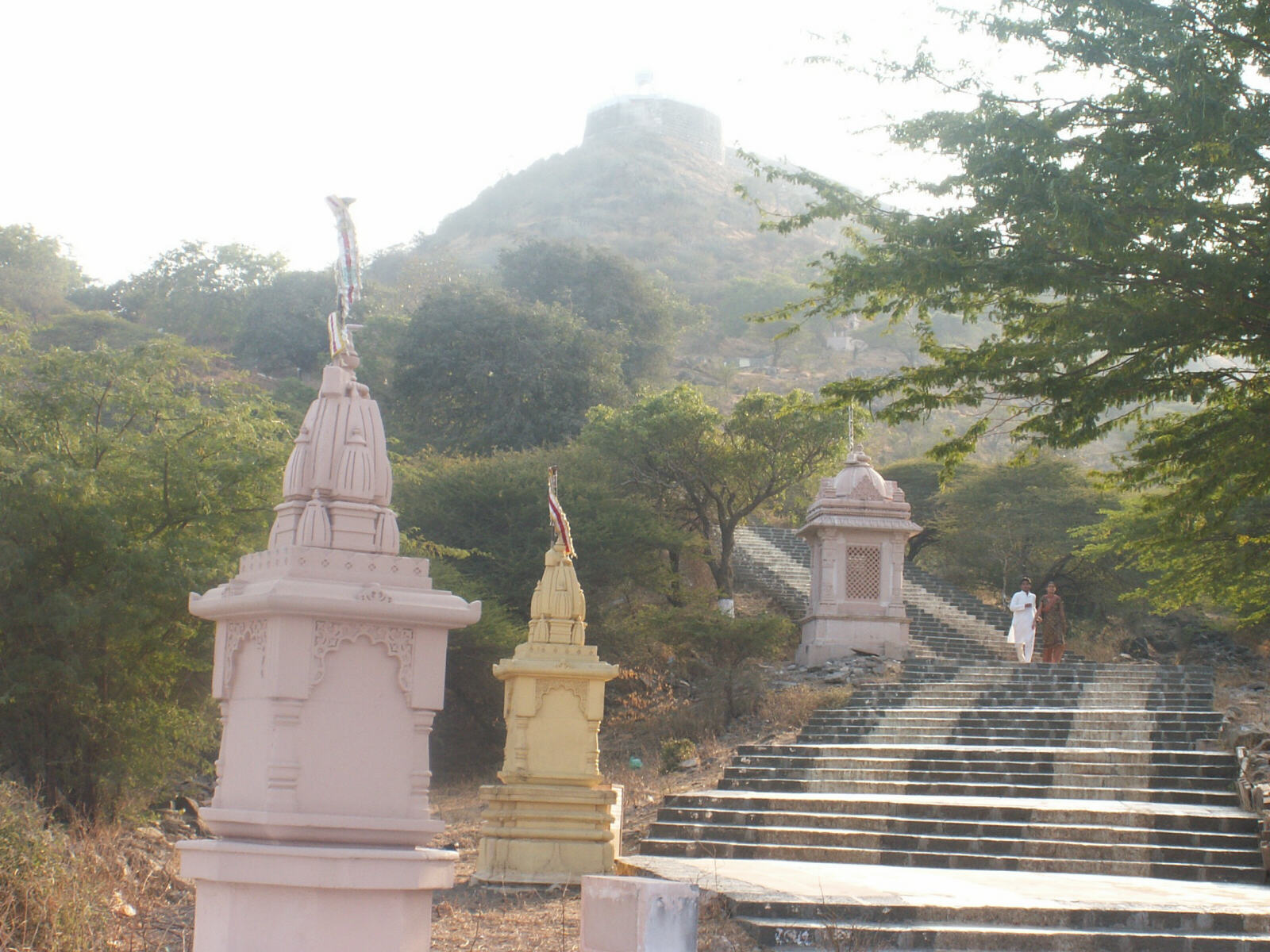
|
Red in the face and exhausted we finally arrived at the incredible sea of over 800 temples spread over the hilltop, which is the holiest pilgrimage site for the Jain religion (which separated from mainstream Hinduism a mere 2,500 years ago). |
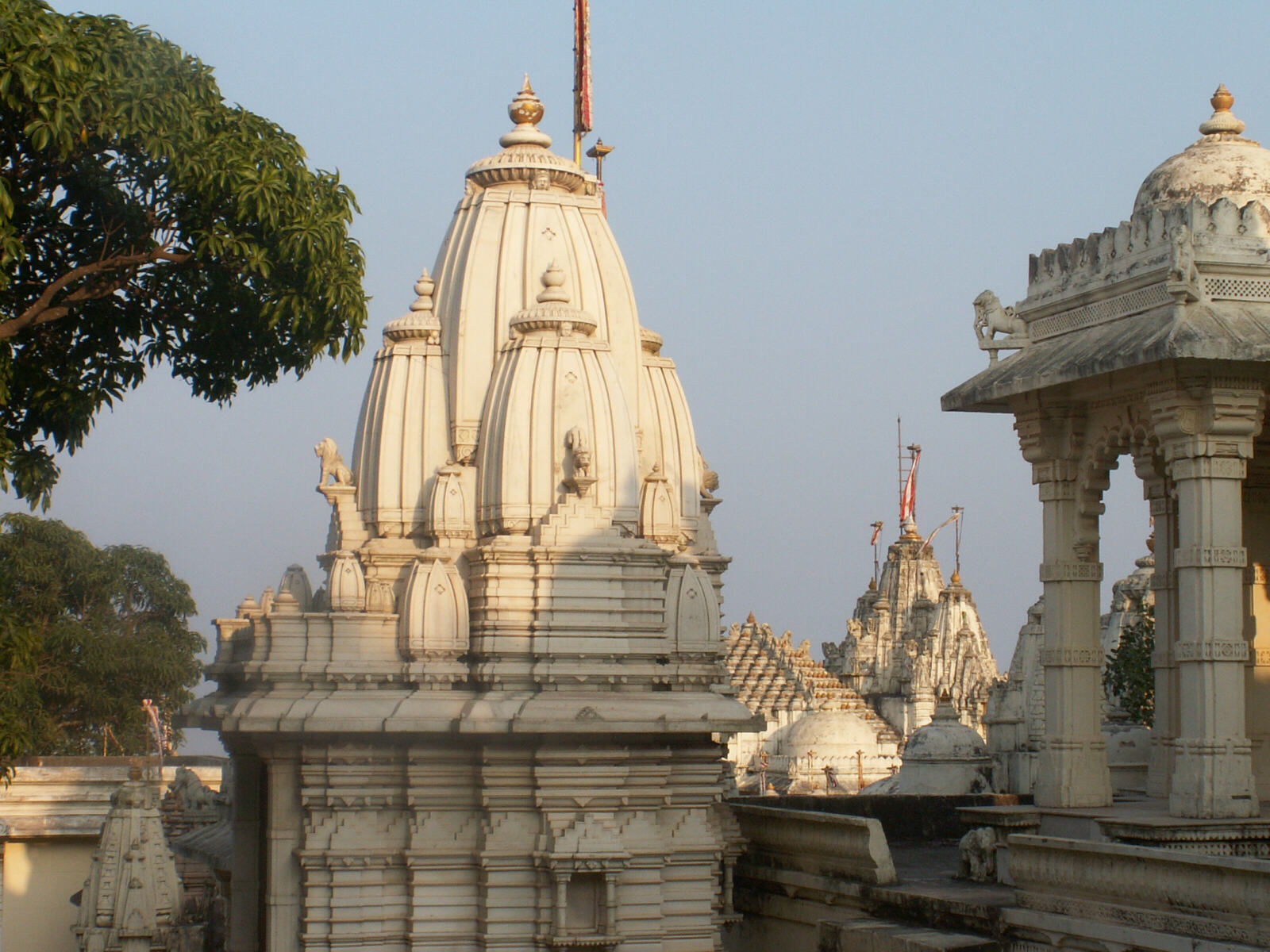
|
We strolled around the temple enclosures appreciating the fine stone carvings then set off on the descent, which was less tiring than climbing up but stressed a whole different set of leg muscles. Most of the way down we were exhorted to go faster by a security guard, because we were the last and it was getting dark. We had arrived at the top with our legs aching, by the time we got down they were shaking like jelly! Back at the hotel, very dehydrated (no food or drink is allowed on the hill) we drank a litre of mineral water each then had two very nice different types of vegetable curries, our first food of the day. |
Daman and Diu union territory
- Diu
|
Fri 16th. Rather than face an even more daunting series of bus rides, the pleasant hotel manager arranged a car to take us to Diu for 2,200 Rs (2000 for the car and 200 his commission). The driver picked us up at 7am and we had an uneventful ride through the Gujerat countryside, arriving at our hotel in Diu around 11am. Diu is a former Portuguese enclave (like Goa) and is a 'Union Territory' separate from Gujerat state. There were several Portuguese-style churches on the low hills behind the town and our hotel was in one of them. The main body of St Thomas' church, approached by a wide flight of brilliant-white steps, is now a museum, while the rooms at the back (and some shacks on the roof) are the Sao Tome Principe hotel. Our room, up its own flight of steps at the back of the building, was light and airy with views across gardens and the spires of St Paul's church to the distant sea. We walked through the town and had a beer and masala papads, followed by egg masala and veg. maharajah (curries) for lunch in the Hotel Alishan's first floor open restaurant looking out over the sea, as occasional fishing boats went past. I had a cup of tea at the Apara Hotel garden restaurant which was a nice leafy setting but rather fly-blown, then we strolled around town looking at the night food stalls on the harbour and all the bars catering for visitors from across the water in Gujerat, which is a dry state. While Sheila slept off the lunchtime beer I climbed up the little steps right onto the curved roof of St Thomas church and took photos, keeping well away from the edge because they don't bother with safety features like guard rails! |
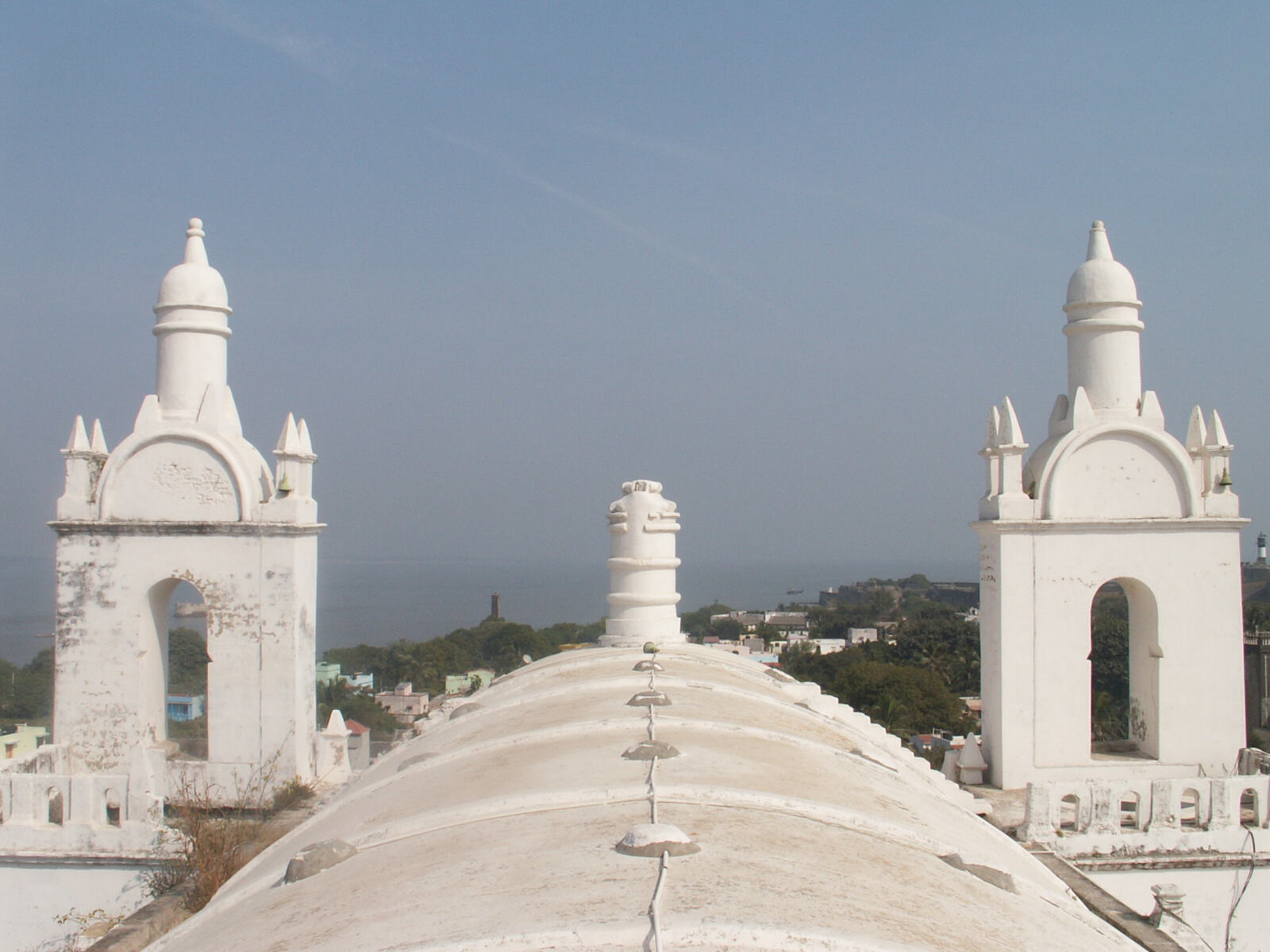
|
The front of St Thomas' church in Diu, illuminated at night. |
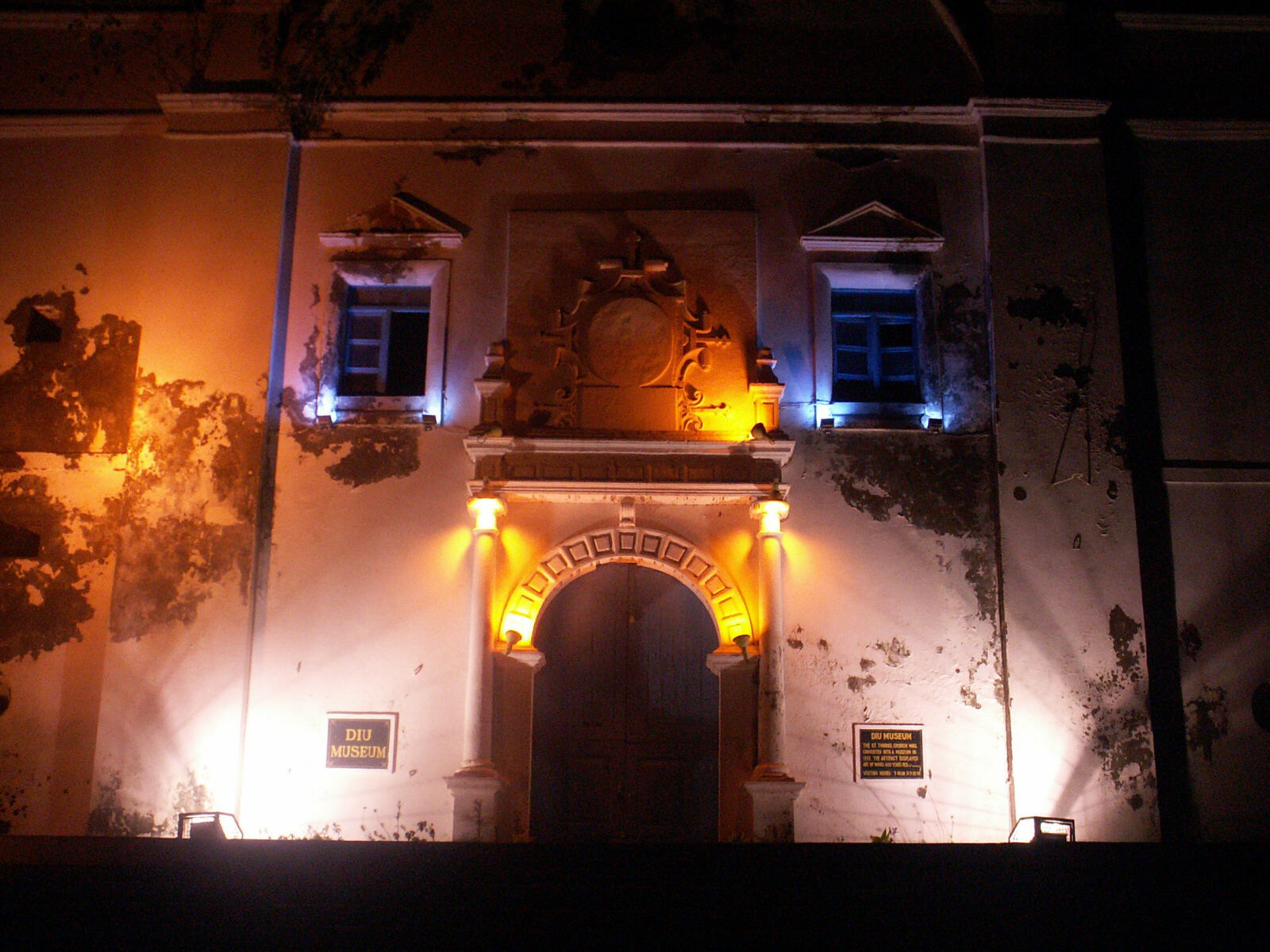
|
Sat-Sun 17th-18th. Relaxing in Diu. We checked out of the Sao Tome Principe because they are cashing in on their good write-up in Lonely Planet by charging too much (800 Rs) for a poorly-maintained room with blocked drains, and don't provide soap, towels or toilet paper. We went instead to the Sanmaan Palace hotel in an atmospheric old Portuguese villa right on the waterfront, and had the large, airy room 101 with a living room with a bow window overlooking the sea, nice big bedroom and a clean bathroom with a toilet that actually flushed, along with all those other little facilities that the previous hotel lacked, and all for 600 Rs. The staff were very friendly and helpful and we had breakfast in the pleasant rooftop restaurant overlooking the seafront. We got an auto-rickshaw down to the fish-market and bought some seriously big prawns for 100 Rs, which we took back to the Hotel Alishan restaurant where they promised to cook them tonight, then went back to our hotel Sanmaan Palace where they said what fish had we bought, they would cook them for us - too many choices! |
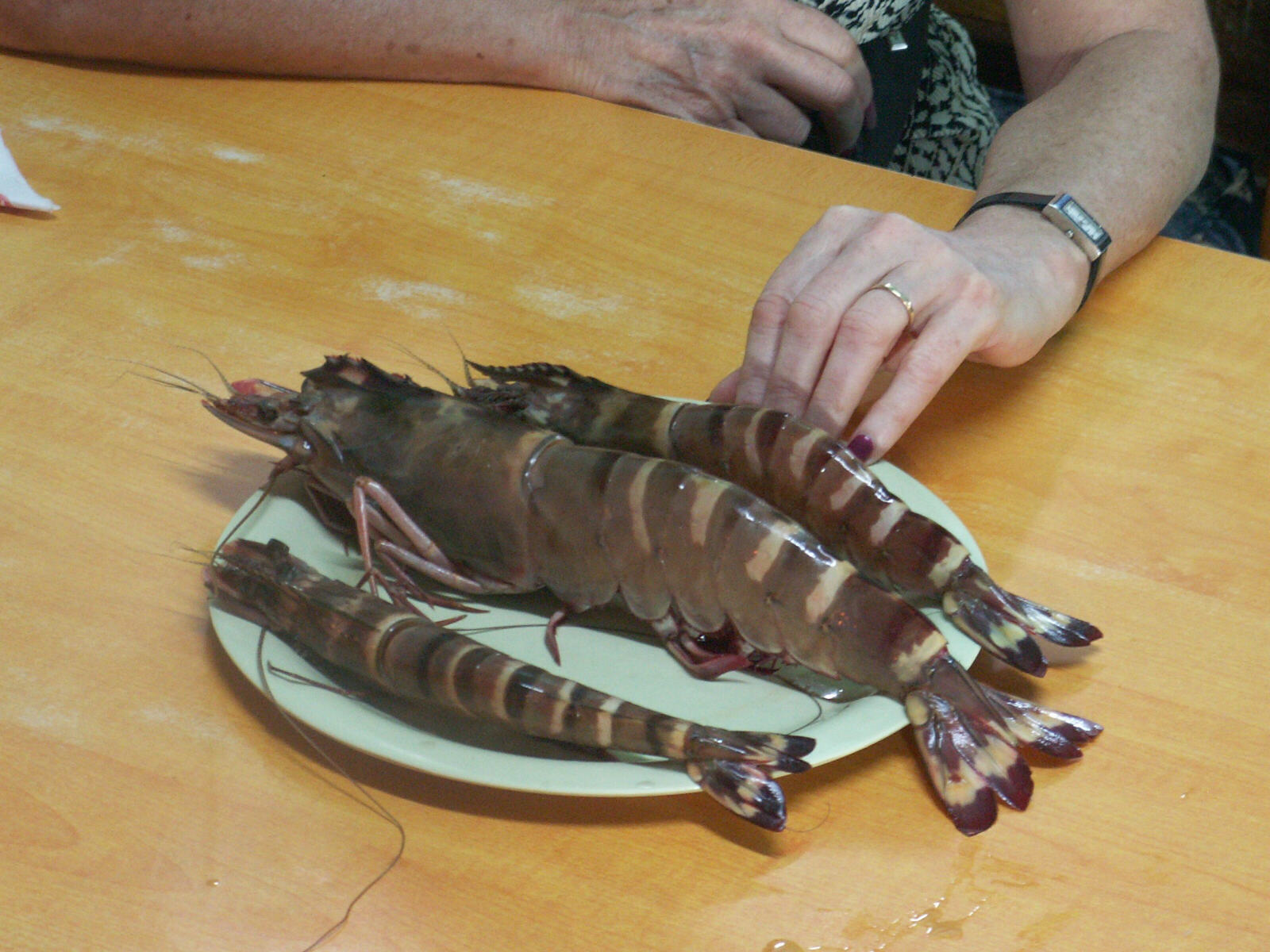
|
Even at midday the heat was pleasant rather than oppressive, so we strolled in the sun down the waterfront Bunder Road to the old Portuguese fort on the tip of the island. |
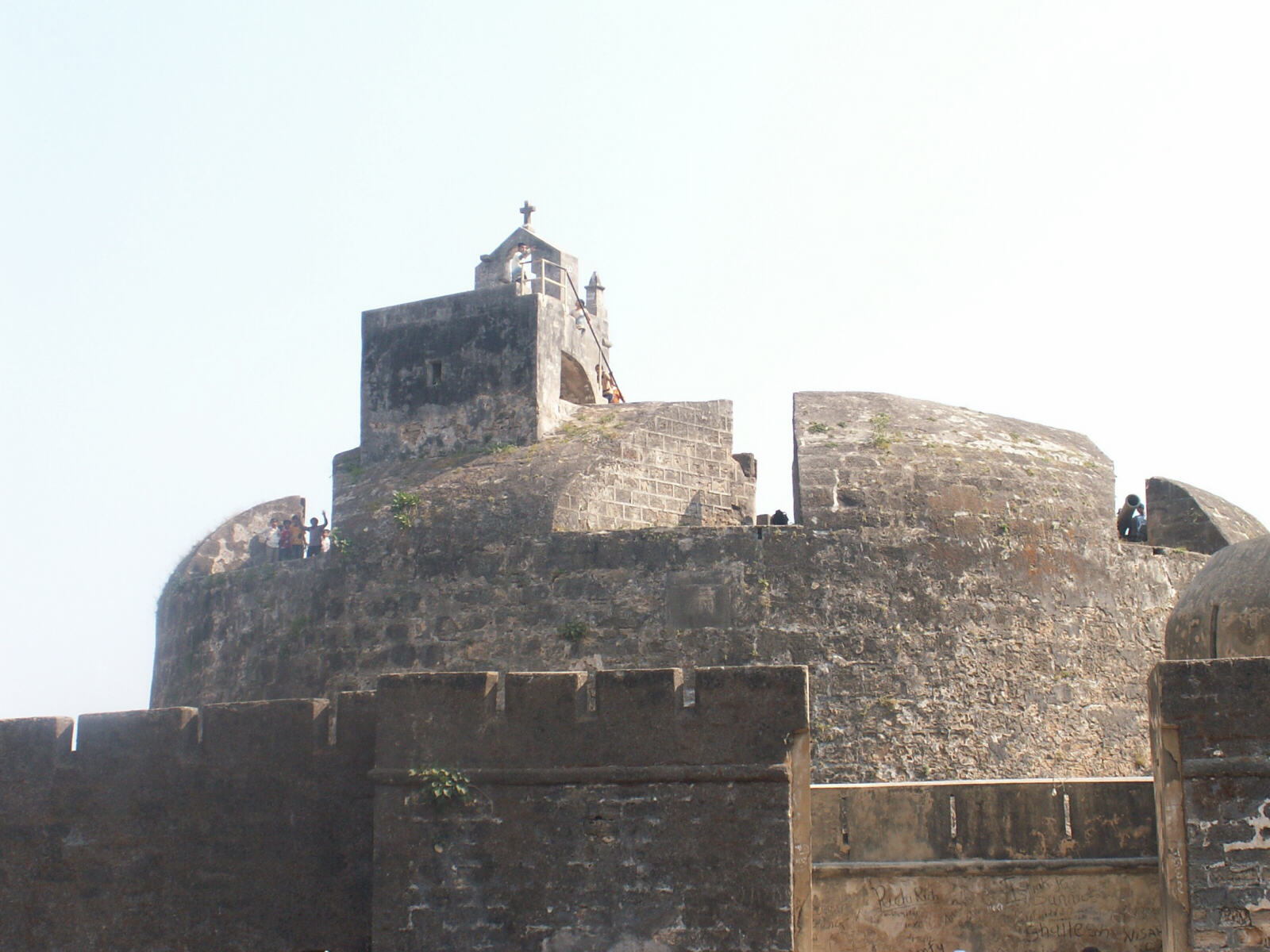
|
The fort was very impressive, just what a fort is supposed to be like, with lots of bastions to climb up (although our legs were still aching from the 3,200 steps in Palitana), old cannons, ruined chapels and surrounded by battlements and a moat. |
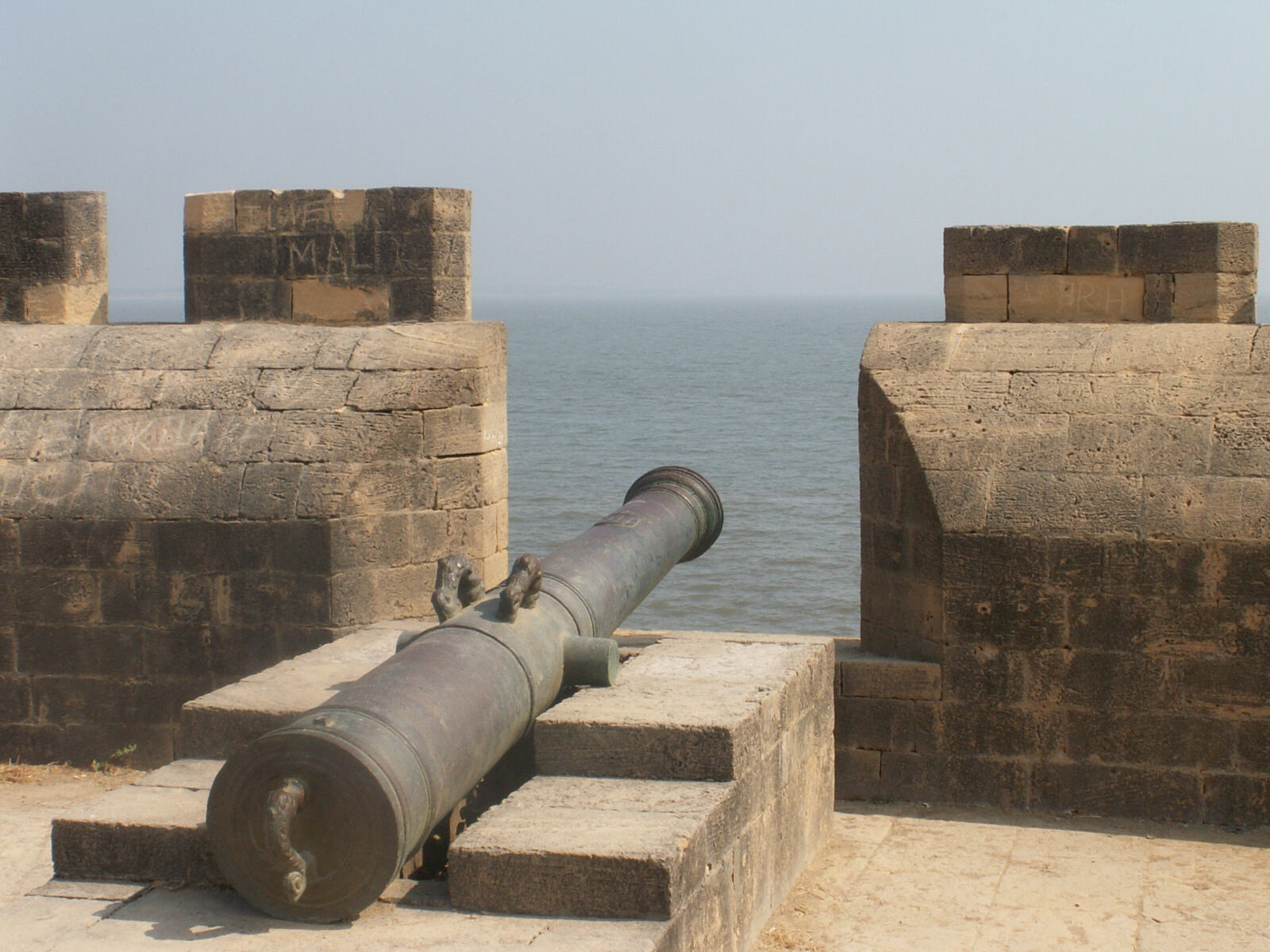
|
There's no entry charge and the place was full of Indian tourists and school children having a good time which gave it a festive feel. After soup for lunch on the rooftop of our hotel, Sheila went to the beauty parlour for some pampering while I walked around the old city gates and the streets with crumbling, elaborate Portuguese villas. One evening we met Mr Ashish Mukherje, the 'maitre d' from the Alishan restaurant and went to the other fish-market across on the mainland, and after some extensive negotiations bought one huge tiger prawn and two big ones, and went back to the Alishan where they cooked them in garlic and butter. Absolutely delicious!
Mon 19th. We are enjoying chilling out in Diu and we really like our big room at the Sanmaan Hotel, so we're staying another day. In fact we were really lazy and had room-service breakfast, eggs on toast, in our living room. Then we went down to the morning fish-market to buy our dinner, and this time chose five crayfish for 400 Rs. We dropped the crayfish at the Alishan restaurant, then went to the town square where we found the Post Office hidden away up some steps. Then we noticed a fishing boat had just arrived so we went across to the dock to watch them unloading the fish .... |
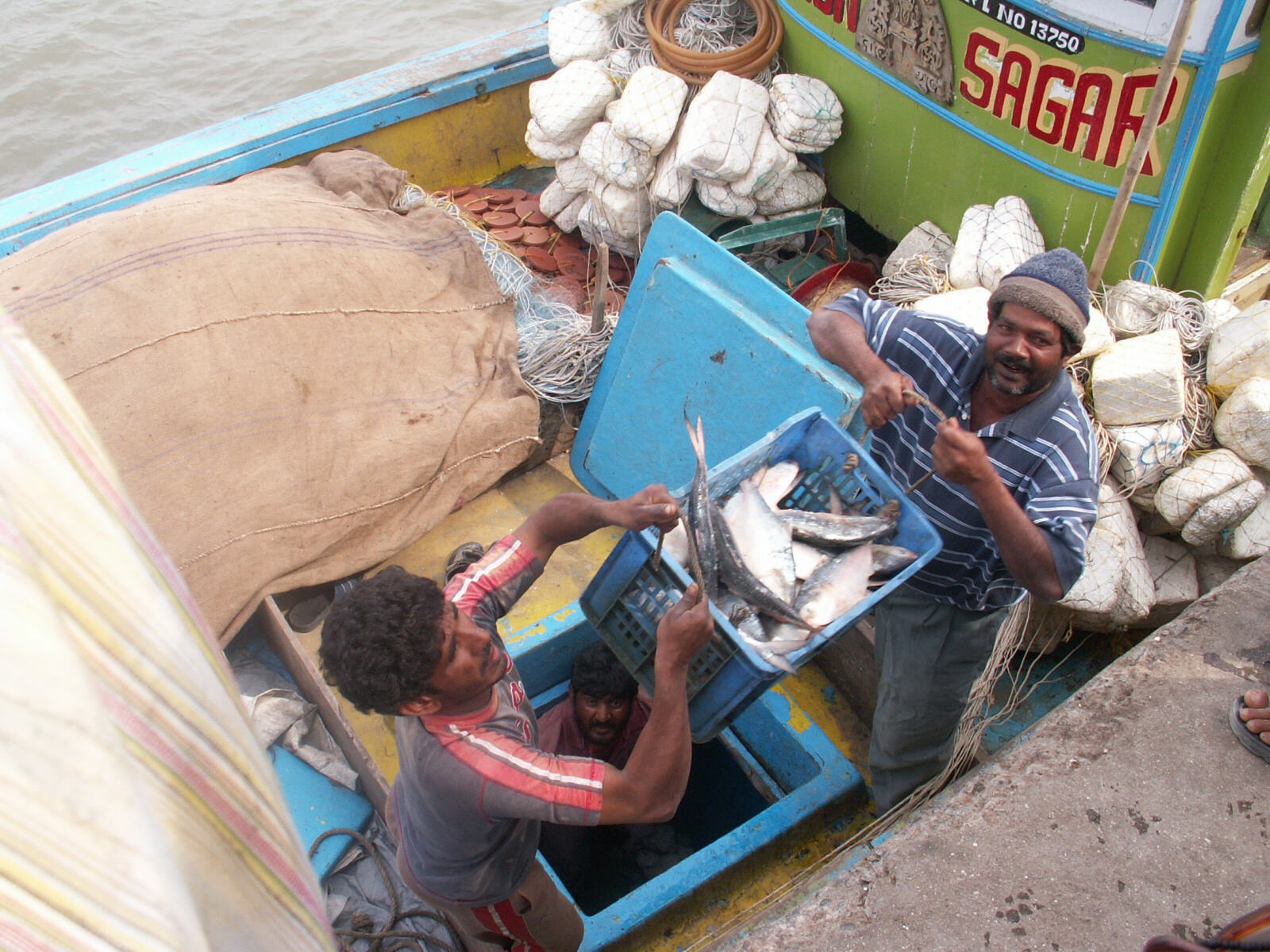
|
.... hauling them up in crates and tipping them into a three-wheel rickshaw-type 'pickup truck'.
|
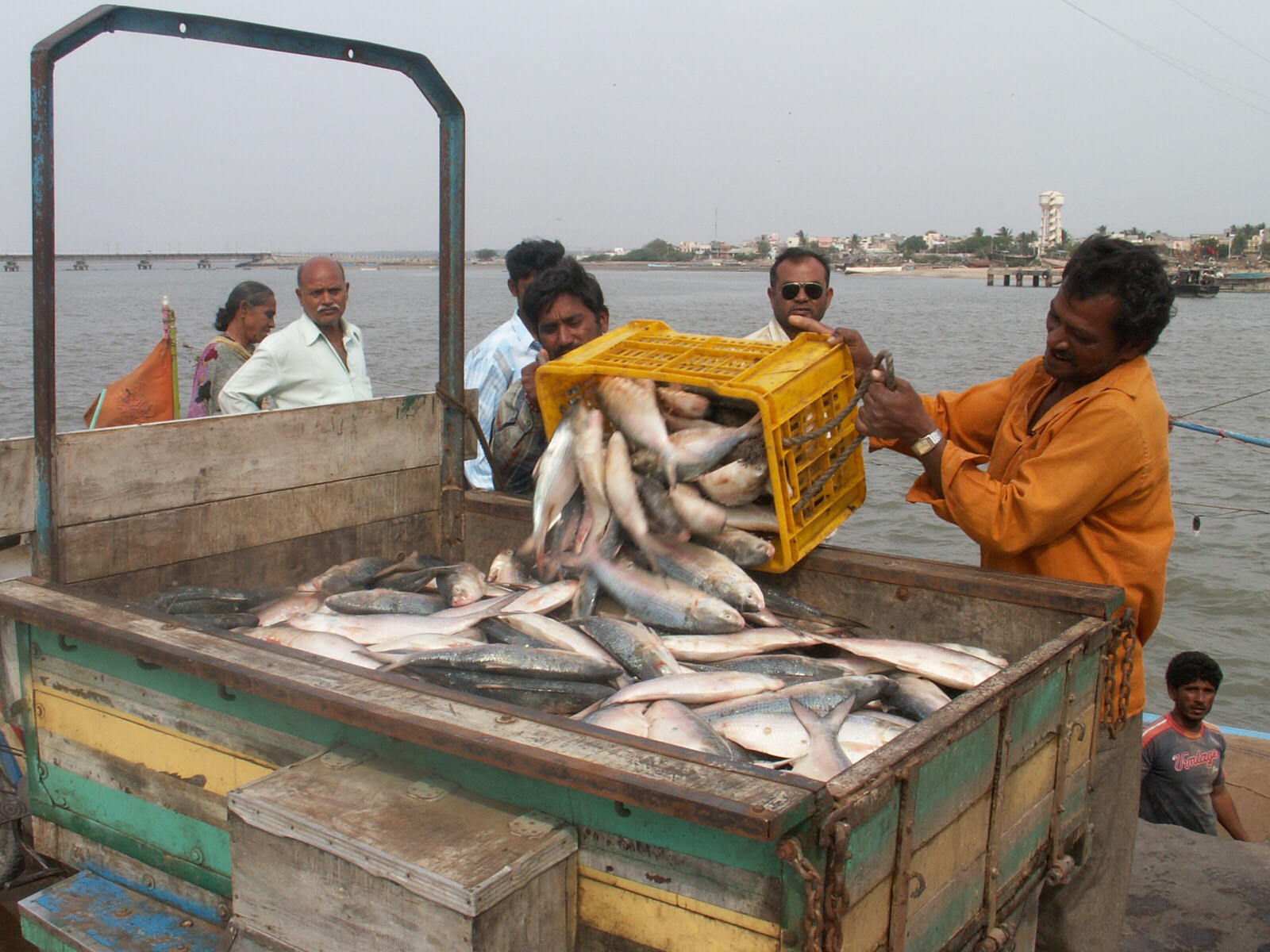
|
Nearby was the jetty where the boat trips start from, but there were no other passengers waiting so we hired the whole boat for 90 Rs and had a nice trip along the waterfront, seeing Diu town from a different angle, and out to the fort and Pani Kota, the former jail which seems to be 'floating' out in the bay, and back. |
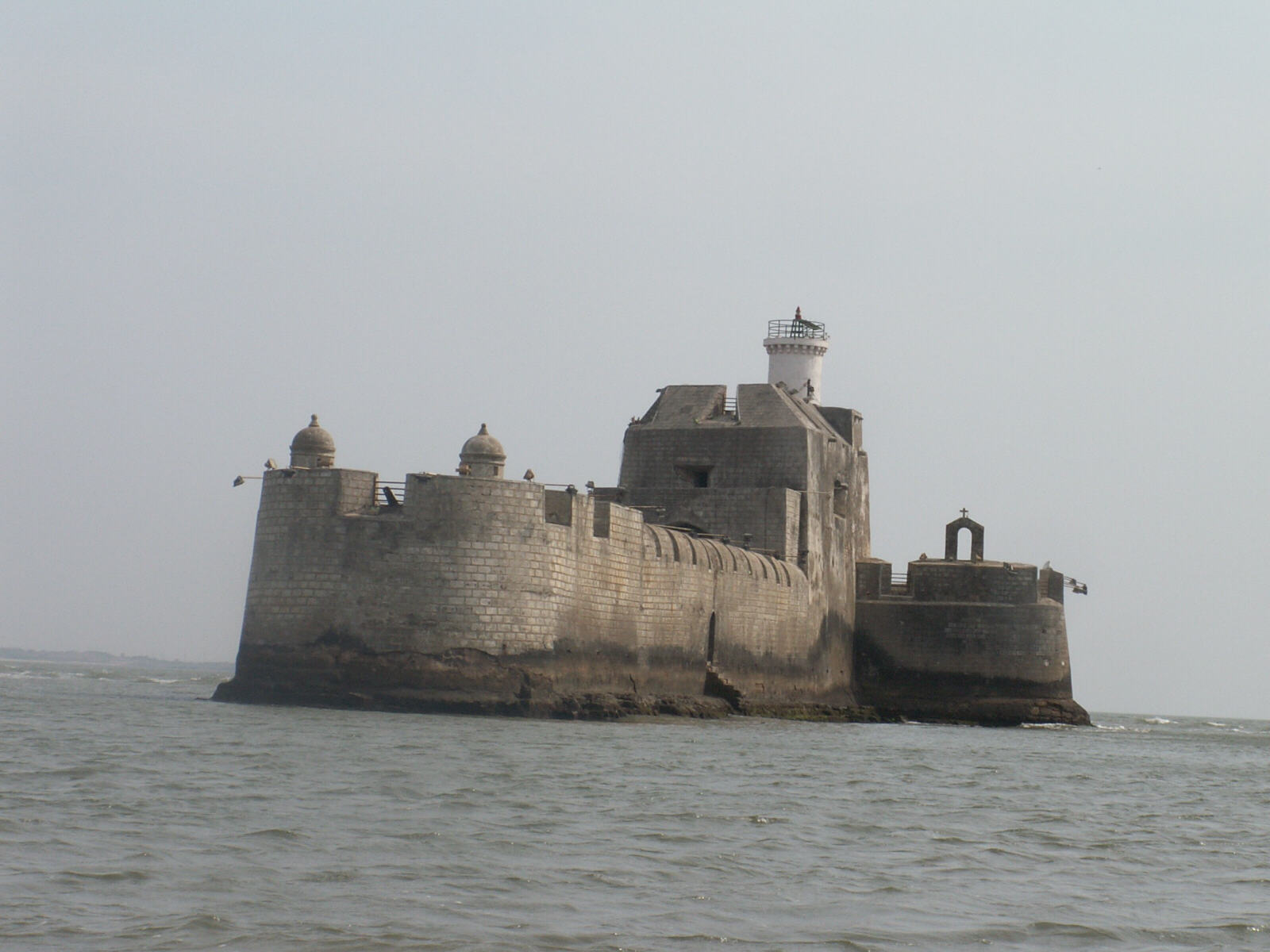
|
Next we got an auto-rickshaw out to Nagoa Beach, where the Gujeratis come to play. The beach was full of groups of ladies in saris paddling in the waves, and crowds of exuberant youths, most of them already drunk even though it was only about midday. After posing for countless photos with them, it all got a bit too boisterous so we retired to a first-floor café to watch proceedings from a safe distance. We were joined by a giggling couple in their 30s who downed a huge slug of whisky even though they had clearly already had a few, then they insisted we all go to find the beach photographer to take a photo of us all to commemorate the occasion. We made our escape and went back to Diu, stopping on the way at the Shell Museum. After a rest we had another walk around the town, and went to Hotel Alishan to eat the delicious crayfish, which they cooked in various herbs and spices. |
Gujerat state
- Somnath and Veraval
|
Tues 20th. We had become good friends with Mr Ashish Mukherje at Hotel Alishan and he arranged for a friend of his to take us in his car to Junagadh 'at cost' of 2,000 Rs, which is exceptional as none of the other drivers or agencies we asked would negotiate below 3,000. They came to pick us up from the Sanmaan Palace at 8:30, we said goodbye to Mr Ashish and we were on our way. First stop after three hours or so was the historic temple at Somnath, in an imposing position overlooking the sea, which has recently been rebuilt in the old style and was full of cool marble floors and carved pillars.
A few kms down the road is the fishing and boat-building town of Veraval, where we took pictures of the hundreds of boats moored in the harbour .... |

|
.... and went into a couple of dhow-building yards to see the big wooden boats being hammered together from a selection of unlikely-looking planks.
|
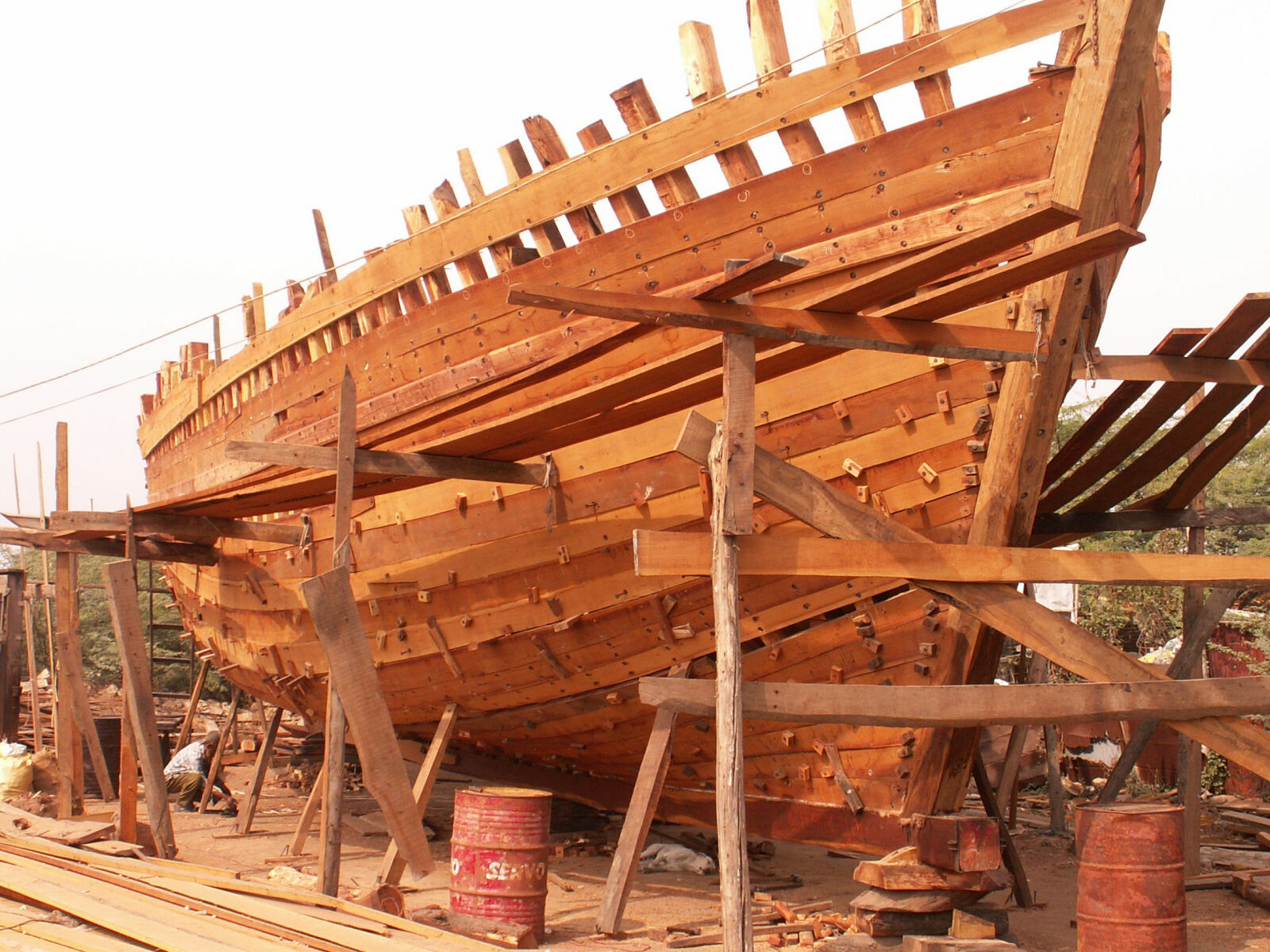
|
They even invited us up the rickety ladder to see the 'work in progress' inside the boat, which was a truly impressive patchwork of shaped beams and planks. |
- Junagadh and Jamnagar
|
We arrived in Junagadh at about 2pm and went to the Relief Hotel, which is conveniently situated in the old town. Junagadh is a hot and dusty but fascinating place with no apparent tourists, and we walked up the bustling narrow street to the impressive fort at the top of the hill. As well as other points of interest there are two amazingly deep, rock-cut wells inside the fort, with hundreds of steps carved in the rock down to the rather grubby water at the bottom. We walked back through Diwan Chowk, a bustling bazaar area, and on to Mahabat Maqbara, which is the mausoleum of the former nawab of Junagadh. It's exotic and lavishly decorated, with domes and inscriptions, and four minarets encircled by spiralling staircases. We had to climb up one of them, of course, to see the view from the top, although chunks of the masonry were so loose that a casual lean would send you and them crashing to the ground. |
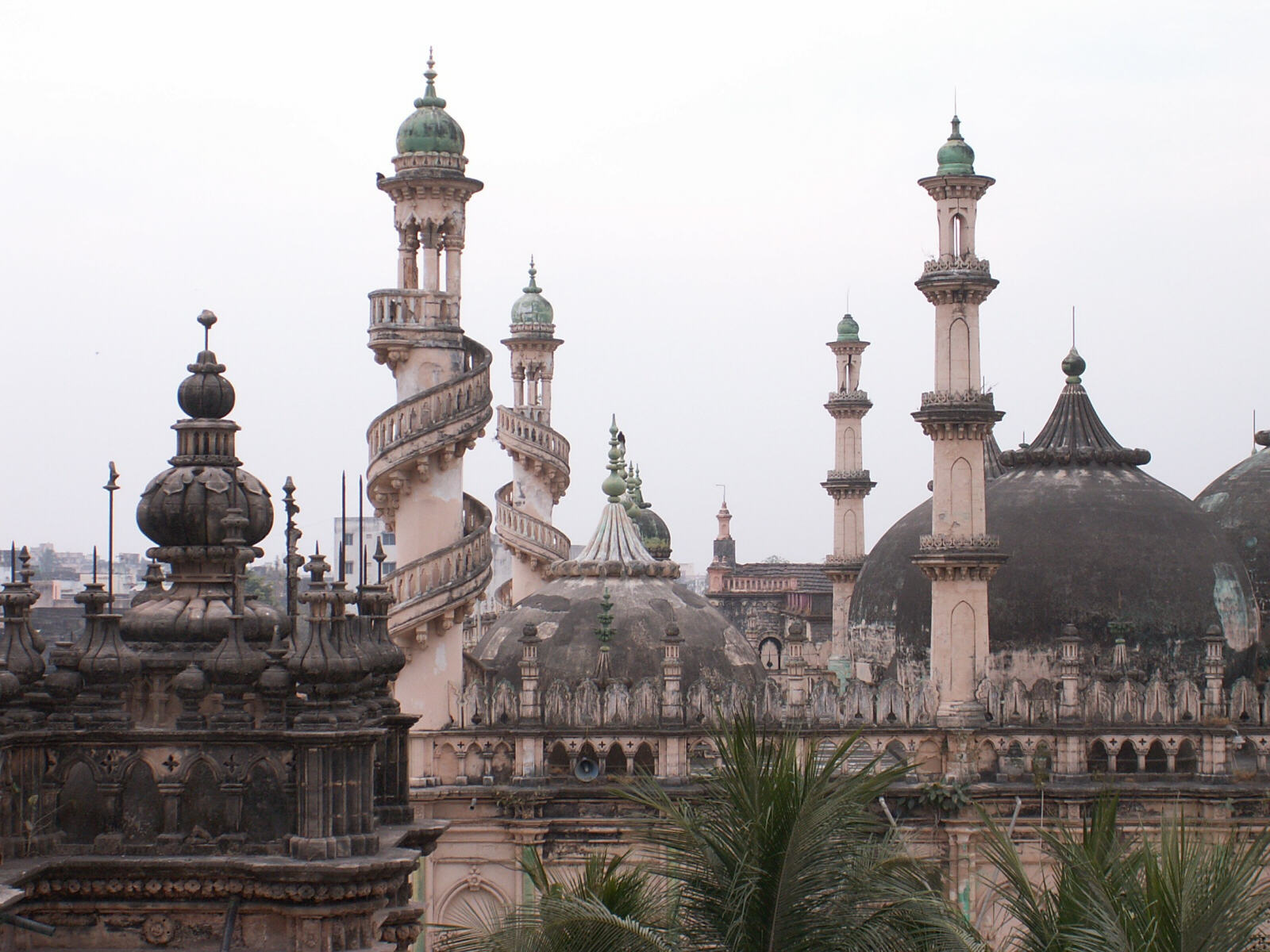
|
We walked back across town to the Santoor restaurant, hidden away down a side street, which was well worth it for two kinds of delicious vegetable curries, with all the chutneys and accompaniments.
Wed 21st. Our Ambassador car arrived at 8:30 as arranged and we drove through the flat, dusty Gujerat countryside on the four-hour trip to Jamnagar for 1000 Rs. The journey was uneventful except when we stopped at a tea stall and discovered that one of the tyres was flat. Fortunately there was a tyre repair shack next door to the tea stall, and in 15 minutes we were on our way again with the inner tube all patched up. In Jamnagar we went to Hotel Ashiana but unfortunately all the nicer top floor rooms were full so we stayed in one of the darker lower rooms. After a refreshing soup we went on a walking tour of Jamnagar, past the clock tower, down winding streets to the Shatinath Mandir temple (closed) and to the Darbar Gadh, a bustling square with a semicircular old palace, where the maharajahs of Nawanagar once held public audiences. It was interesting, busy and bustling, but the people were not as smiley and friendly as in Junagadh. We continued down to the river (a toilet) but it smelt too bad to stay long, so we walked back via Mandri Tower to the Bala Hanuman temple to witness its Guiness Book of Records entry, for continuous 24-hour chanting since 1st August 1964. We walked round the nearby lake which was occupied by all sorts of aquatic birds. The Lakhota palace, perched picturesquely in the middle of the lake, is closed on Wednesdays, so we walked past the town hall and had a tasty early dinner at the Seven Seas restaurant in the President Hotel - butter chicken, egg curry and the usual pickles - wonderful! We had a short walk around the bazaar in the evening but had to spend all our time dodging speeding motorbikes and auto-rickshaws and could hardly look at the shops.
Thurs 22nd. We had a leisurely stroll to the Seven Seas to have fried eggs for breakfast, then went down to the lake to visit the museum in the Lakhota Palace. The Lakhota Palace was a lovely, white building with gentle cooling breezes from the lake through the courtyards and windows. |
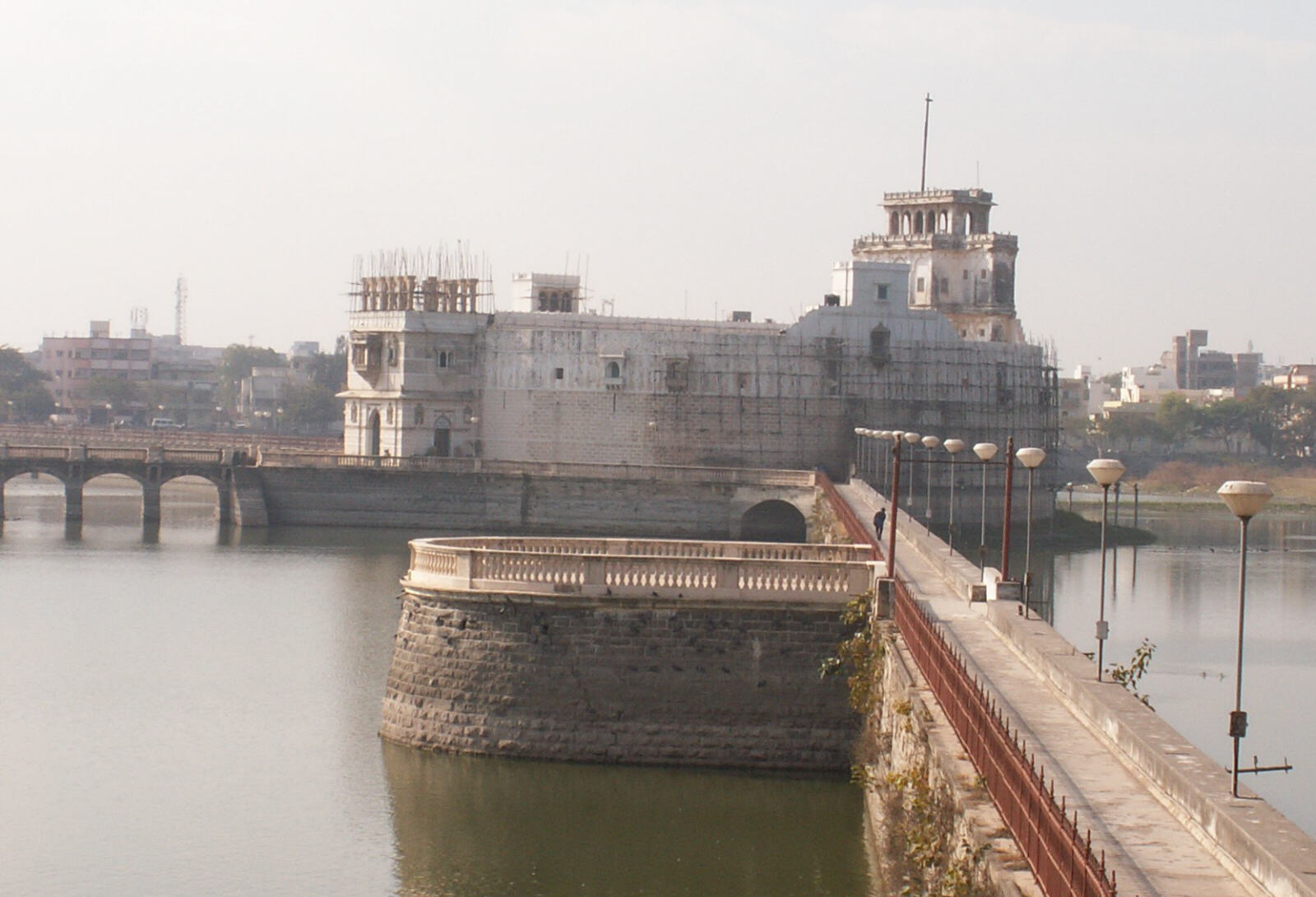
|
Along the way Sheila tried to pretend she wasn't nervous of the big camel! |
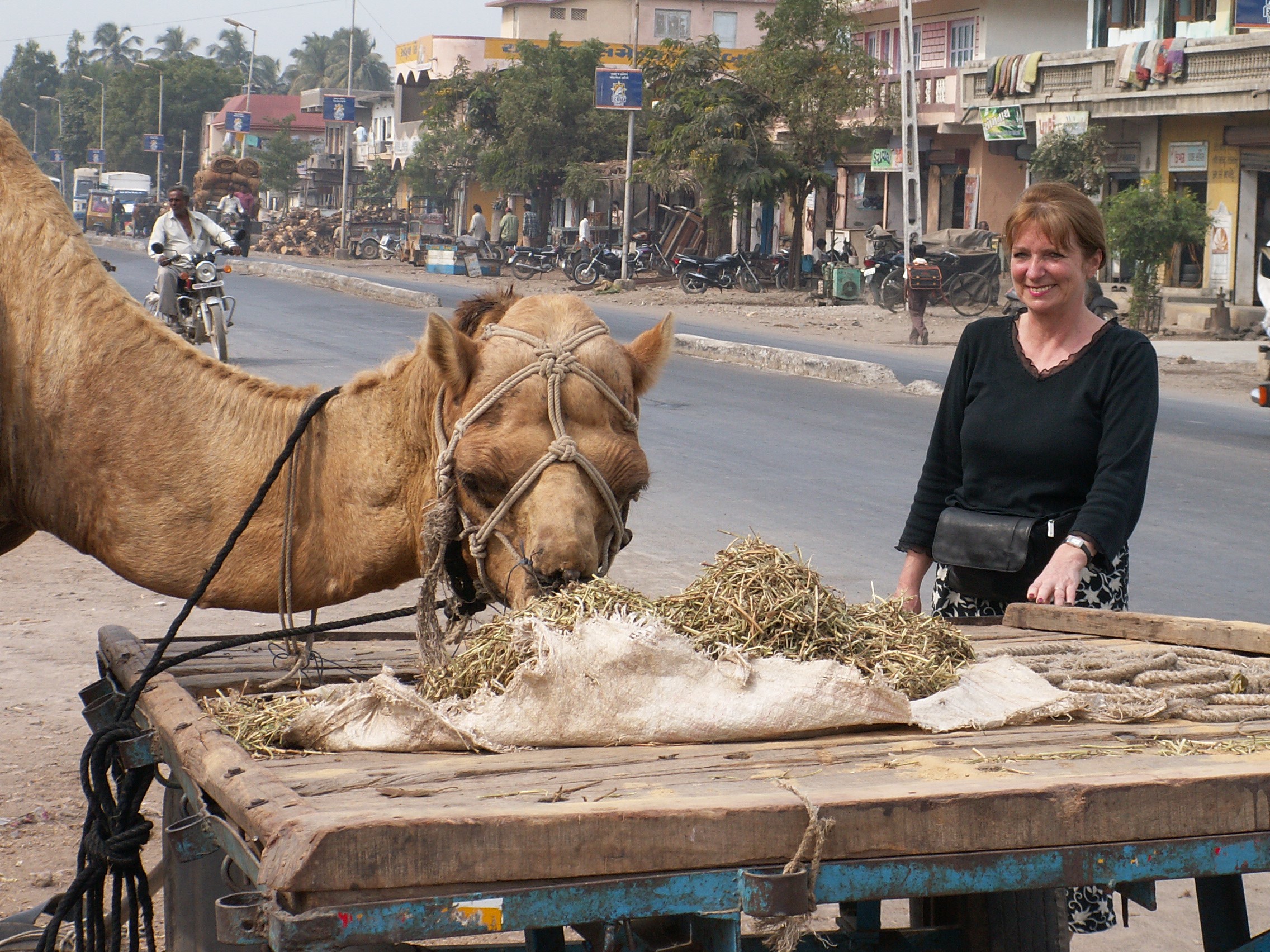
|
We stood on the little balcony of our hotel room watching the crazy traffic and camel carts at the road junction below until it was time to go and get the train. The extremely helpful man at hotel Ashiana had arranged our train tickets and now he laid on the hotel courtesy car to take us to the railway station, which was very kind and saved us hassling with an auto-rickshaw. We caught the 13:35 Janata Express to Ahmedabad and dozed and watched the countryside from our comfortable 2A seats (2-tier A/C) - nice and roomy, but rather over-air-conditioned and chilly. While we were waiting on Ahmedabad station we had a spicy omelette sandwich from a vendor on the platform for dinner, then got the 21:50 Suryanagari Express to Jodhpur in Rajasthan. We could only get 3A seats (3-tier A/C), which were rather cramped with all the other people and their luggage around, above and below us and no room to sit upright, but all we had to do was sleep so we made the best of it. |
To continue to part 2, Rajasthan and Punjab, please click the elephant.

|
